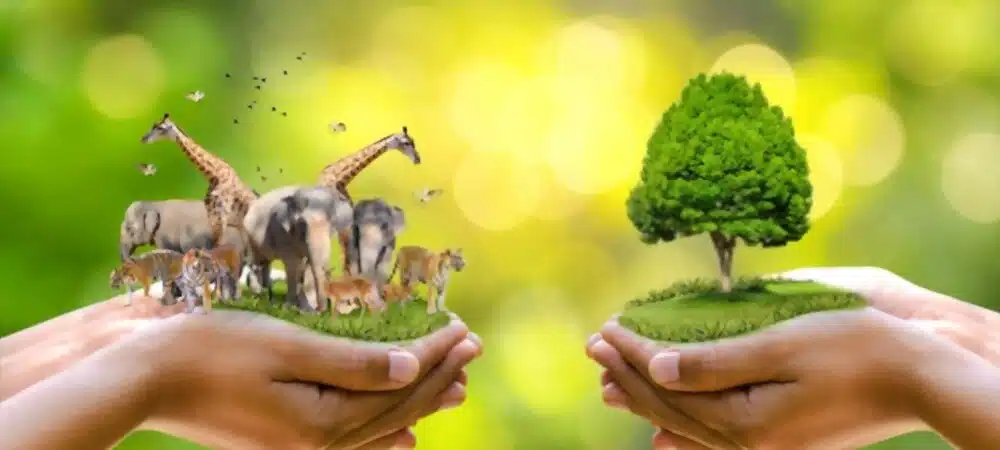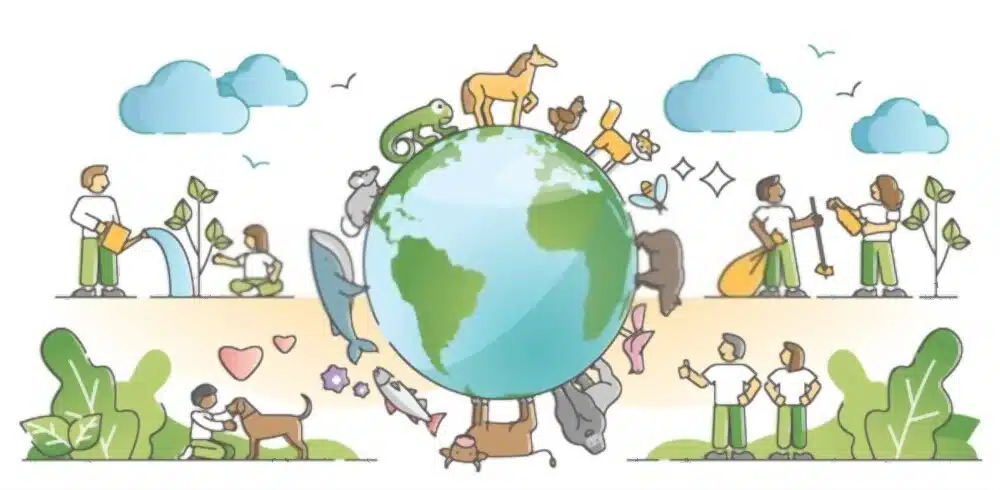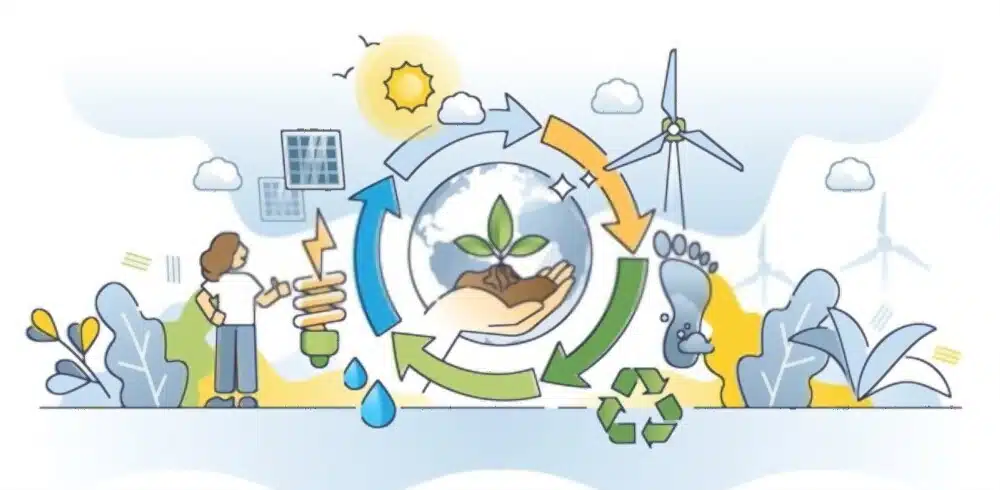
Conservation of Plants and Animals
Conservation of Plants and Animals means protecting them. The ecosystem of this world is full of diverse life forms, from big creatures like whales to the smallest insects; every living thing plays a very significant role in maintaining the balance of the world. But humans are disturbing this ecosystem in the name of so-called development.
Deforestation, pollution, and other various harmful activities of humans are causing various important plants and animals to face extinction. Now it’s time for all of us to step forward and raise voice against it. If we don’t do that the balance of this ecosystem is going to be severely disturbed. We’ll explore some of the key issues surrounding plant and animal conservation efforts and discuss what we can do to help protect these vital parts of our environment.

Also Read:
- Essay on Animals in English
- Essay on Hypertension
- Essay on Causes of Obesity
- Essay on My Father My Hero
- Essay on the Improving Perception
The Importance of Conservation of Plants and Animals
As the population done by humans is increasing at a rapid rate which is worrisome. So keeping some factors in mind, we must conserve our resources and shouldn’t be wasting them. It is necessary for the survival of humans and nature.
If we keep depleting our forest reserves, water reserves, and other useful natural resources a lot of animals and plants will go extinct which will lead to a huge scarcity of natural resources.

Why Conservation is Important
Conservation of plants and animals is no doubt necessary for a number of reasons, including:
- Biodiversity: Plants and animals are essential components of the Earth’s biodiversity. Conservation efforts ensure the protection of the diverse range of species that exist on our planet.
- Ecological Balance: Plants and animals are vital to maintaining ecological balance. For example, animals play an important role in pollination, which helps plants to reproduce and plants provide shelter and food for animals. The loss of one species can have a devastating effect on the entire ecosystem.
- Human Survival: Plants and animals provide humans with food, medicine, and other essential resources. Conserving them helps ensure that these resources remain available for future generations.
- Economic Benefits: Plants and animals are essential for various industries such as agriculture, forestry, and tourism. Conservation efforts can help protect these industries by ensuring the long-term sustainability of these resources.
- Aesthetic Value: Many plants and animals are culturally significant and provide aesthetic value. Conservation efforts can help preserve these species for their cultural and aesthetic significance.
Some more specific reasons for why Conservation is Important-
- Conserving the different types of plants and animal species helps us to have more resources. The fewer the species are the fewer the resources will be. If we don’t preserve it and save it all we may face huge shortages of food and resources in the future which will be nothing less than a nightmare turning into reality.
- Moreover, a lot of species of animals and plants help in maintaining the quality of water by filtering pollutants out of the water supply. If we do not conserve these animals, our water could become polluted and unsafe to drink.
- Conservation will ensure safety from climatic changes as plants and animals play a very important role in maintaining and regulating the environment.
Methods of Conservation
There are so many ways to conserve plants and animals. Here are some common methods of conservation-
- Habitat Conservation – This includes the conservation of natural habitats like forests, wetlands, and grasslands. This will make sure that animals and plants have a place to live without the worries of being cut or hunted which will promote their growth too.
- Species Conservation – This includes the conserving of those plants and animal species that are on the brink of extinction. This can be achieved through re-introduction programs, managing hunting and fishing quotas, and captive breeding programs.
- Land Conservation – This includes conserving land to provide shelter and other resources for habitat conservation or other purposes such as recreation or agriculture. This can be done by buying or selling the land for conservation or changing the way land is used ( for example changing farming to organic farming).
- Water conservation – This involves conserving the water to ensure that it is returned to its natural state and being used more effectively. It can be done through reforestation, greywater systems, and rainwater harvesting.
- Resource Conservation – This involves conserving natural resources such as trees, minerals, and soil so that they can be used sustainably. This can be done by, using recycled materials, recycling the resources, and using renewable resources instead of non-renewable resources.

If we go in deep there are these two major conservation methods which are described further below –
In-situ Conservation
So first of all let’s understand what is In-situ Conservation-
This conservation is the conservation of an endangered species in its natural habitat which can be achieved by creating national parks, nature reserves, and other protected areas. In-situ conservation is often considered the most effective way of conserving biodiversity.
The main advantage of this conservation is that it enables the species to adapt to the variating environment. If any species is facing extinction due to climate change, in-situ conservation will enable them to adapt to the new conditions of their changing environment. Moreover, in-situ conservation protects against habitat loss and fragmentation.
Although this strategy of conservation isn’t perfect and has some problems too, let’s discuss what these challenges are –
- The difficulty of establishing protected areas in countries where there are high levels of poverty and political instability.
- Moreover, species in the protected areas can face genetic problems as they will be isolated from the other areas.
Ex-situ Conservation
Now let’s see what is Ex-situ Conservation-
To protect species they are moved to a more controlled habitat from their natural habitat and this is what we call ex-situ Conservation. This can be done through captive breeding, tissue culture, cryopreservation, and other methods.
The reason why ex-situ conservation is necessary is described below –
In situations where a species is threatened by habitat loss or degradation, over-exploitation, introduced predators or diseases, or climate change. In that case, taking individuals out of the wild and into captivity will help to ensure their survival and their safe return to the wild later on.
Although there are many disadvantages to this strategy though –
- It is often expensive.
- It is difficult to recreate those natural conditions in captivity.
- Captive animals may become less genetically diverse over time.
- Moreover, there is always a chance that captive animals could escape from there and establish themselves in the wild and may even prey on native species or compete with them.
Overall ex-situ conservation should be seen just as a tool that is to be used alongside other strategies
Conclusion
Conservation of plants and animals should be of the utmost priority as we can see how much environmental damage is being caused due to the imbalance in the ecosystem. Through conservation, we must ensure that there is a proper balance in the ecosystem. We all need to put efforts at the individual, and community levels. It needs the government’s support and assistance too to protect the environment and ensure the safety of all endangered species. It is also important to protect the habitats of animal species so they can live safely in their natural environment. By working together, we can create a more sustainable future for us, our planet, and wildlife.
FAQs
1. Can anyone give me an essay on cruelty to animals?
Answer – With the rise in human population and advancement in technology, there has been an increase in unethical treatment of animals. Cruelty against animals can come in various forms such as physical abuse, neglect, exploitation for entertainment purposes, animal testing for commercial gain etc.
It is important to understand that cruelty against animals is completely unnecessary and immoral and we need to take action against this issue if we want to ensure the safety of animal species and maintain the integrity of the ecosystem.
We must create awareness about animal rights and promote strict laws to protect them from such cruelties. Additionally, setting up recovery centers and rescue shelters across the country will give these deprived animals a chance at life and hope that things will get better for them someday.
2. What is the importance of the conservation of plants and animals?
Answer – Conservation of plants and animals is of paramount importance as it provides balance to the environment and helps preserve natural resources for future generations. Conservation helps maintain biodiversity, protect habitats from destruction, protect endangered species, and ensure the sustainability of the ecosystem.
Without conservation efforts, many plant and animal species would become extinct, which would disrupt the balance nature needs to continue its ecological cycles.
Additionally, conservation helps improve air quality, contribute to flood reduction, reduce soil erosion and water pollution by preserving healthy ecosystems. It is therefore important to secure a sustainable world for future generations.
3. In what ways can private citizens help in the conservation of plants and animals?
Answer – Private citizens can play a crucial role in the conservation of plants and animals. Here are some ways individuals can contribute to conservation efforts:
- Reduce the Environmental Footprint: Private Citizens can reduce their impact on the environment by consuming less energy, reducing waste, and making sustainable choices in their daily lives. For example, individuals can use public transportation or they can go for carpool, reduce water consumption, and recycle.
- Support conservation organizations: There are many non-profit organizations dedicated to conservation efforts. Private citizens can support these organizations through donations or even spread awareness about their work.
- Practice sustainable agriculture: Individuals can support sustainable agriculture practices, such as buying locally sourced produce and support organic farming, and avoid products that contribute to deforestation, such as palm oil etc.
- Report illegal activities: Private Citizens can report illegal activities, such as poaching or habitat destruction, to the relevant authorities.
- Educate others: Private citizens can educate others about the importance of conservation and inspire them to take action.
4. Which NGOs are working for conservation of plants and animals in NCR?
Answer – There are several NGOs working for the conservation of plants and animals in the National Capital Region (NCR) of India. Here are some examples:
- Wildlife Trust of India (WTI)
- World Wide Fund for Nature (WWF)
- Bombay Natural History Society (BNHS)
- Centre for Wildlife Studies (CWS)
- Indian Wildlife Conservation Trust (IWCT)
5. Why is it important to protect endangered species?
Answer – Endangered species are facing extinction due to several reasons. A few reasons include habitat destruction, climate change, over exploitation and other threats. It is important to protect these species as they play an important role in maintaining the balance of nature. Protecting endangered species helps preserve our planet’s biodiversity and ecosystems, which are essential for human survival.
By preserving rare and unique species, we can also maintain genetic diversity which is very critical for developing new medicines, treatments, and crops. In addition, protecting endangered species provides us with enjoyment and spiritual enrichment by preserving nature’s beauty for future generations.
6. Do plants have a higher conservation value than animals?
Answer – Both plants and animals have high conservation value, and it is difficult to say which has a higher conservation value. Both are basic components of ecosystems and play critical roles in maintaining ecological balance.
- Plants provide a variety of ecosystem services, including oxygen production, carbon sequestration, soil stabilization, and nutrient cycling. They also provide food and habitat for a wide range of animals. Additionally, many plants have cultural and medicinal importance, and their loss can have significant impacts on human communities
- Animals also provide a variety of ecosystem services, including pollination, seed dispersal, and pest control. They also have cultural and aesthetic value, and their loss can have significant impacts on human societies. Additionally, animals are often important indicators of ecosystem health and can serve as flagship species for conservation efforts.
7. How do I control my urge to torture animals?
Answer – Controlling your urge to torture animals is an important step in promoting the conservation of plants and animals. We should remind ourselves that animals suffer the same emotions as human beings and therefore we should never mistreat them for any reason.
Instead, we should focus on finding positive ways to interact with them, like going to animal shelters or joining organizations that help protect them. We can also educate ourselves on humane alternatives to animal testing and advocate against cruel practices. Ultimately, respect for life is essential in our journey towards conserving plants and animals.